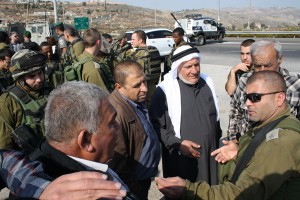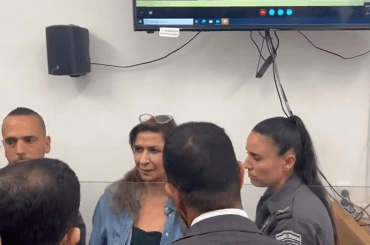
It’s barely 100 meters, but a fence Israel plans to build through four villages in the heart of the iconic hills of the West Bank shows how deep the occupation reaches into Palestinian life.
Earlier this month, the Israeli Defense Forces (IDF) ordered the construction of a separation fence in the north central West Bank on agricultural land belonging to four Palestinian villages. The “security fence,” or “security wall,” from the Hebrew and Arabic appropriation orders respectively, will run east-west along highway 5, near Tapuach Junction, a checkpoint between Ramallah and Nablus.
This fence is not an extension of the famous separation barrier. Rather it will be a free-floating chain linked plank in the heart of the West Bank. A miniature version of the wall, it separates nothing and can easily be bypassed on foot. It only stretches 3.8 dunums in length, well under one kilometer. Still this fence is part of a patchwork of barriers in the Nablus district that trace the highway system.
The fence is slated for construction on farms lands belonging to the hillside localities of Beita, Osrain, Qabalan and Yitma. Together the four villages form a square with two to the north and two to the south of an Israeli highway. The planned path of the fence lines the bisecting highway.

“Based on my jurisdiction as a leader of the Israeli Defense Forces in this district,” states the November 3rd appropriation order I obtained, signed by Nitzan Alon, the Israeli army commander of the West Bank. “I think it is necessary for military purposes and based on the special security conditions exiting in the area, and this city, to take steps to prevent terrorist operations.” The document goes on to state the Palestinian landowners have seven days to file an objection.
“There have been several updates covering attacks occurring at Tapuach Junction,” said the IDF in response to the construction of the fence. An army spokesperson pointed to one Israeli killed and one stabbed at the intersection, however, they were not able to provide any data regarding security threats specific to the outlined path of the fence.
“It’s not ‘the separation fence,’ it’s ‘a separation fence,’ said Ray Dolphin, barrier specialist with the United Nations Office for the Coordination of Humanitarian Affairs. Dolphin explained this fence is replacing a previous divider. Yet the Israeli army was unable to explain why that one was dismantled. Dolphin said there is other fencing along this road and these blockages are common in the Nablus region, layering additional burdens to Palestinian movement. Still the new fence does not cut access to the framing highway network.
Then earlier this week on Monday around 20 Israeli border police arrived at Yitma Junction to give landowners a field tour of the confiscation area. But the walk through never happened. Instead 40 Palestinians met the army with a demonstration. “We will stay here all day,” said one of the middle-aged landowners. Yet within a half-an hour the Palestinian dispersed back inside of their villages.

The row over the fence zone dates to 2010 when farmers were initially prevented from reaching their orchards. That same year a confiscation order was delivered to the village councils, leading to a lengthy court battle. At the beginning of this year Israeli judges refused to overturn the appropriation edict.
In response the Palestinian villagers have selected to appeal through legal channels. There are no weekly Friday protests like the ones made famous in Bil’in and Nabi Saleh. Instead the village councils work with lawyers from the Palestinian Authority who have yet to garner any return of the territorial loss.
Moreover in September 2013 alone, Yitma received demolition orders for 21 houses. “They [the IDF] said that these homes are outside of Yitma villages on Israeli land,” said Ahmad Snobar, a 27 year-old advertising manager and son of the president of Yitma Village Council. “We have visits from the army every week from two to five o’clock in the morning when everyone sleeps,” Snobar continued.
Yitma and the other villages losing land for the security fence are in core of the West Bank’s iconic rocky hill region. Yitma is home to only 6,000 Palestinians and the total population for all of the villages under the confiscation order is barley 40,000. In typical housing patterns, the Palestinian villages are on the lowlands and small settlements are perched on nearly every visible swath of highland. Standing on the soon to be confiscated land, in every direction there are settlements towering over Palestinian villages. It’s no surprise then that Nablus district has the highest rate of settler violence, a fact underscored by Snobar departing from our interview to rush to an adjacent village where settlers had chopped down Palestinian olive trees.
Unlike the path of the separation barrier which follows the Green Line in places before stretching deep into the West Bank, this fence has absolutely no connection to Israel’s internationally recognized border. After 2003 when the path of the wall was first announced, the Israeli government augmented the route three times and adjustments were made after construction through court orders.
“The High Court in all cases has reduced the route of the wall,” said Dolphin. In cases like Bil’in where the path of the wall was constructed outside of the published route, the court ruled the wall must coincide with the plans outlined by the Ministry of Defense. But this little Nablus area fence is not subject to the same rigor as the separation barrier. The army can order its seizure at will.
So while Israeli and Palestinian leaders are meeting to discuss a negotiated partition, in the West Bank backlands this small fence marks no letting up from Israel on usurping even seemingly insignificant tracts of land. In recent weeks the Israeli government has announced they hope to secure a borderline along the path of the official separation wall. In that case, this fence would be well inside the future Palestinian state. Moreover, earlier this month Israeli officials announced the expansion of the separation wall along the border with Jordan. Such a barrier would also fall beyond Israel’s stated territorial scope. Yet this little fence, attached to nothing that can reasonably be bypassed on foot within minutes, will be built under military order in center of small farms in the West Bank.


Sounds disgusting. Pure evil, undisguised. Discrimination and ill-treatment of people for the sake of discrimination and ill-treatment, and nothing more.
The gloves are off. Israel is openly flouting the good opinion of “the world”. When is “the world” going to respond?
This (as described above) makes no pretence to be done for the safety or security of anybody, nor yet for military necessity. Purely and blatantly illegal. Tell it to your rabbi if you have one. this must be denounced, and so must the rest.
Ray Dolphin wrote a book in 2006 titled “The West Bank Wall”, (The unmaking of Palestine.)
Ironically he dedicated the book to “All those affected by the wall and may they hold on to their land and livelihoods.”
This book is a mine of valuable information.Published by Pluto Press.
ISBN O -7453-2433-9
WWASD?
(What Would Ari Shavit Do?)
I don’t think either “security” or “fence” are appropriate words.
colonization needs language to do some of its dirty work. How about “Wall of hatred and paranoia” instead ?
By itself this stretch of fence seems to make no sense. But it has to be viewed as a small piece of a long-term strategy of harassing the Palestinians, making their lives so difficult that more and more of them get out, driving them off the land and concentrating them in mostly urban isolated ghettoes. My guess is that after local residents have learned to tolerate this stretch of fence it will be extended bit by bit, increasingly cutting off the areas on the two sides.